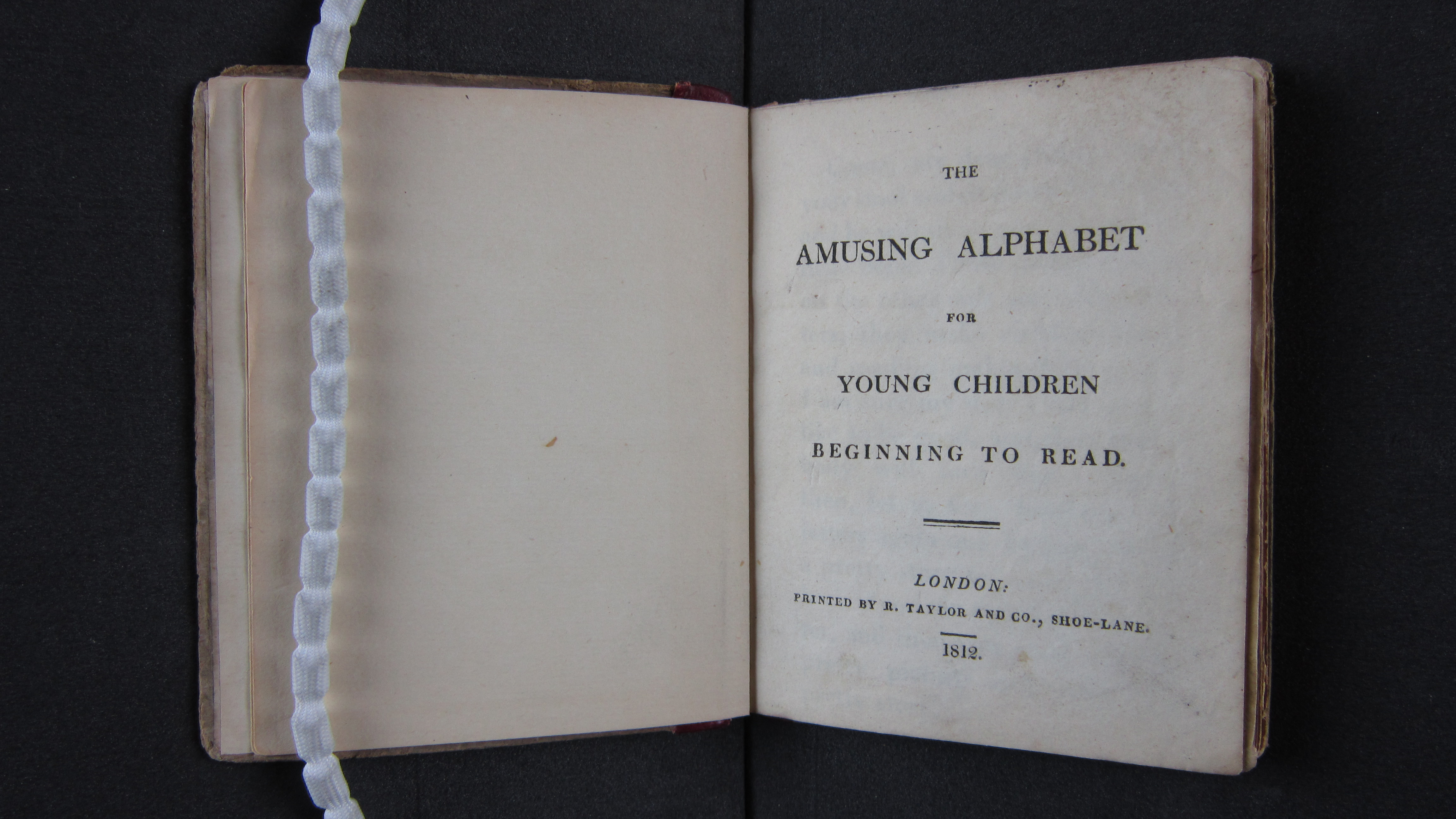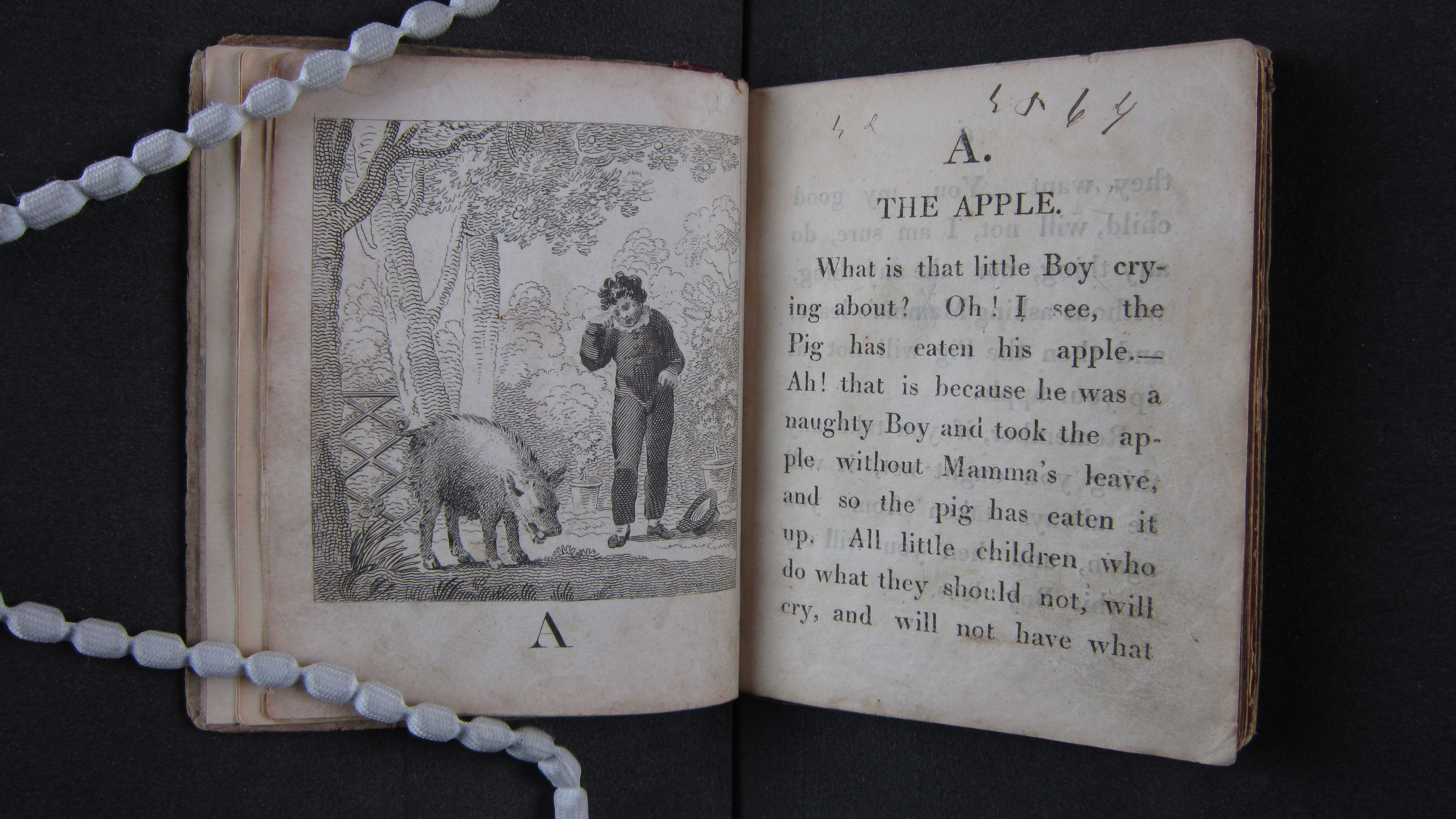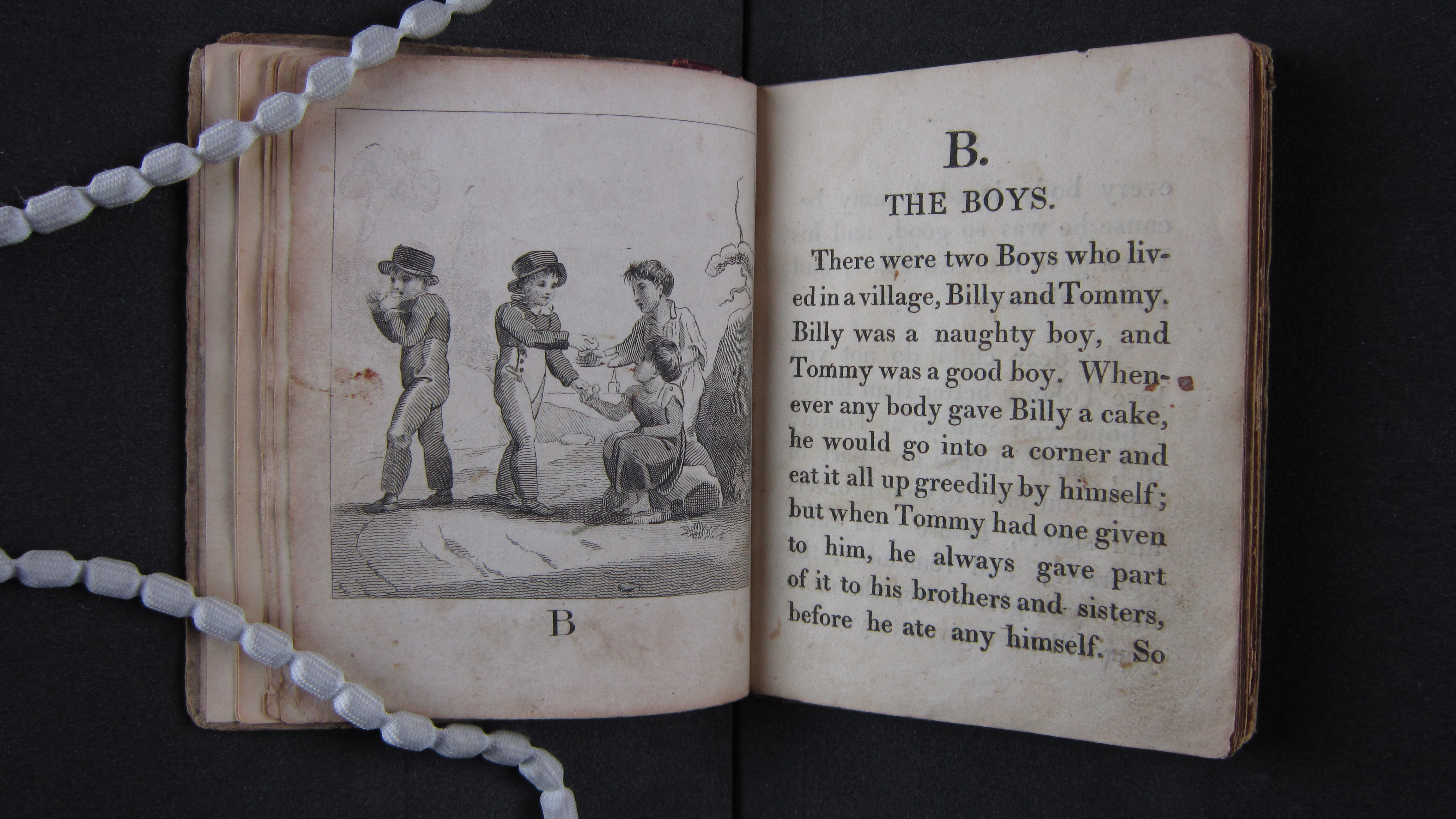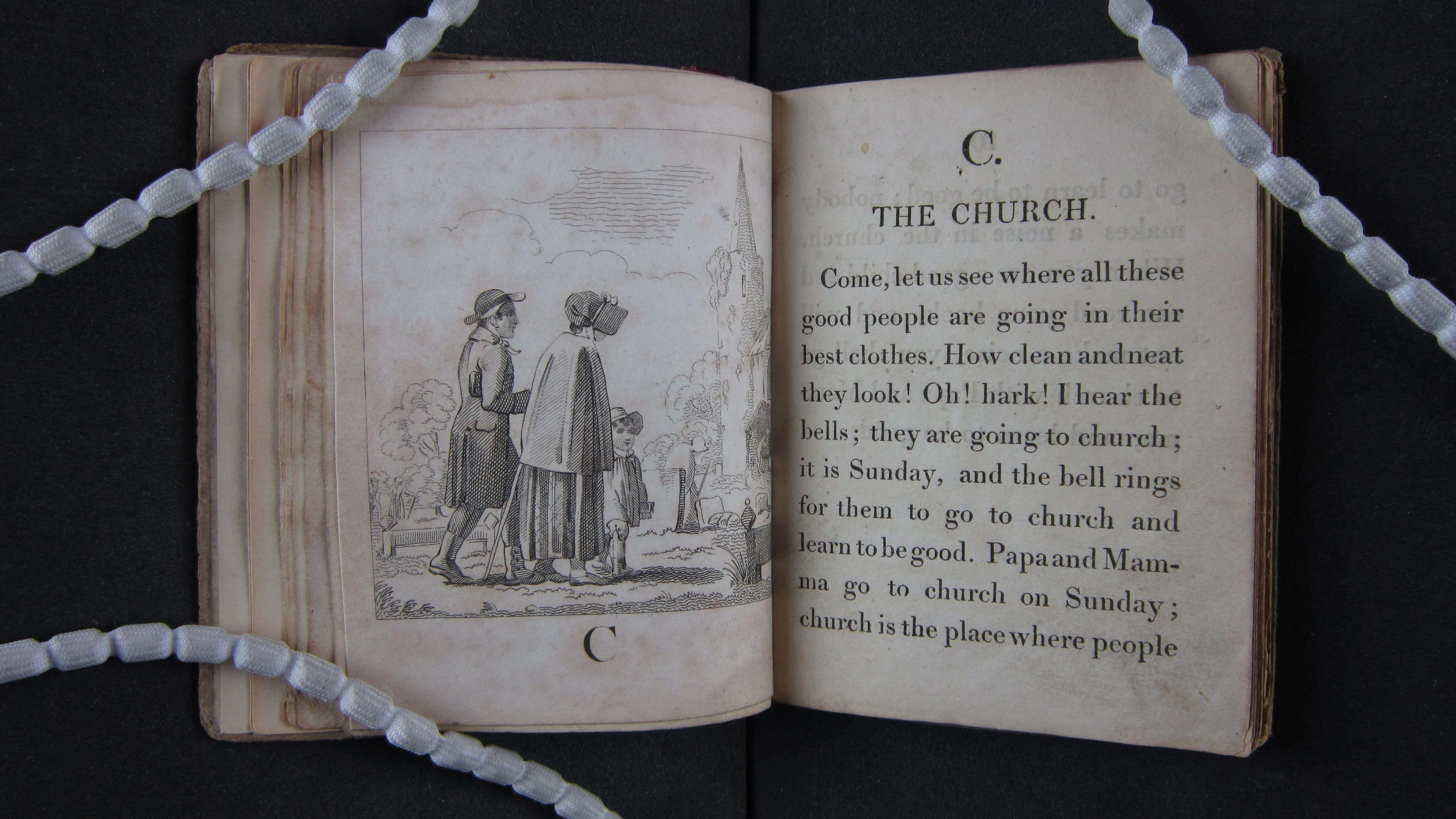

Alphabet books offer a vivid insight into the history of literacy and culture, as well as concepts of childhood. The Children's Book Collection at UCLA contains a rich array of these materials, some well-worn and much-used, some still bright and fresh. Each is a gem of print production and graphical imagery from another time and place. Though the history of alphabet books continues to the present, this exhibit focuses on the works in our collections published between 1700 and 1900, including horn books, primers, works of didacticism and seriousness, whimsy and play.
2. A Jumble ABC
3. A Little Pretty Pocket-Book
4. A New Lottery Book of Birds And Beasts
5. A Pretty Play-Thing for Children of All Denominations
8. ABC of Objects for Home And School
10. ABC with Pictures & Verses
12. Alphabet Et Instruction Pour Les Enfans
16. Dolly's ABC Book
17. Flora's ABC
18. Home ABC
22. Hornbook C. 1700
23. Large Letters for the Little Ones
24. Little ABC Book
25. Little People: An Alphabet
26. Martin's Nursery Battledoor
27. Mother Goose ABC
28. My Darling's ABC
29. Orbis Sensualium Pictus Quadrilinguis
30. People of All Nations: A Useful Toy for Girl Or Boy
31. Picture Alphabet
32. Pretty ABC
33. Railway ABC
34. Rusher's Reading Made Most Easy
38. The Alphabet of Old Friends
40. The Amusing Alphabet for Young Children Beginning To Read
42. The Child's Christian Education
45. The Easter Gift
47. The Favorite Alphabet for the Nursery
49. The Franklin Alphabet And Primer
51. The Golden ABC
55. The Moral And Entertaining Alphabet
57. The Old Testament Alphabet
59. The Picture Alphabet for Little Children
62. The Sunday ABC
63. The Union ABC
64. The Young Child's ABC, Or, First Book
65. Tom Thumb's Alphabet: Picture Baby-Books
67. Warne's Alphabet And Word Book: with Coloured Pictures
68. Wood's Royal Nursery Alphabet
Title The Amusing Alphabet for Young Children Beginning To Read




Brief description
Full description The Amusing Alphabet for Young Children Beginning to Read was an alphabet book narrated in the first person voice. Throughout the book, the narrator reads to his child. This was less an alphabet book than a guide to good behavior.
Each alphabet letter was paired with a short story, usually about a child who displayed good or bad behavior. The stories were followed by praise or criticism of the child, and ended with a plea to the reader to either follow the good examples, or reject the bad. The narrator ended each tale with a subtle reminder that bad behavior was punishable. Engravings depicting each story accompanied the alphabet letters.
Literacy This alphabet book provided insightful clues to the cultural and moral literacy of the early 19th century. Each letter was accompanied by a tale of a child or animal, either behaving properly or misbehaving. Following each tale was a beseeching request from the narrator to the reader, asking the reader to follow only the examples of good behavior. The narrator also warned of the consequences of poor behavior. The tales in the book displayed the understood expectations of behavior, as well as the awareness of the consequences should people not follow the rules set by society. Each child knew his or her place, and knew exactly how he or she was expected to behave.
The format of the book itself displays an expectation of a higher degree of comprehension, for this is no mere code book, with letters and simple visual associations. The concepts depicted for each letter are more abstract than just "A is for Apple." In the book, the example given for the letter "T is Truant." The concept of truancy was far too difficult to convey with a letter and a corresponding image. The readers needed to be familiar with the concept, either because they had attended some kind of formal school, or were expected to attend school in the future.
The accompanying tale warned the reader not to be truant, or else he or she would be punished. The tale reinforced moral expectations and controlled behavior. The language involved displayed an understanding of vocabulary literacy, for truancy was a word that many children, especially those who did not attend school, or who belonged to the working class, would not have recognized. Thus, literacy in the early 19th century was still a way to transmit social and cultural mores to children.
Childhood At the close of the 18th century, the idea of childhood grew more defined. Childhood evolved into distinct stages such as infancy, childhood, and adolescence. Many children began their education at home, whether through family instruction or through local dame schools, and books were written specifically to aid in this instruction of young children.
The Amusing Alphabet was one such book. At the end of each tale, the narrator implored the reader to follow the example of the good children, or else face the consequences. Children's books of this period still enforced morality, yet a light-hearted tone became more dominant. The tales in The Amusing Alphabet are genteel, and though the narrator still issues his admonishment, his tone is stern but loving. Philosopher John Locke's views of childhood, which emerged in the 18th century, were fully accepted in this early 19th century alphabet book.
The illustrations depicted recognizable activities, thus making children's reading and comprehension more understandable and enjoyable. And yet, there were still great expectations placed on children. The tales in The Amusing Alphabet were read aloud by an adult as a way to control behavior and teach proper customs and conduct. As scholar Patricia Crain states, 濡the child is meant to be seen listening. Though children were now indulged with more exciting learning materials, they were still expected to behave as proper, little adults, and to be seen, not heard.
Iconography The plate illustrations of The Amusing Alphabet for Young Children Beginning to Read depict the stories given for each letter of the alphabet. Most of the stories contain a moral, and this is often shown in the illustration. For instance, A is for apple, as it is in many other books, but the illustration depicts a boy crying as he watches a pig eat an apple he had taken" without Mamma's leave." Apart from C being for church, the illustrations and stories are not overtly religious, showing the influence of the Age of Reason, but the text still contains strong moralizing.
The book's constant appeals to emotion (i.e., be kind to poor dear animals) and portrayal of idyllic country life show the influence of Romanticism. Children are often depicted actively and not necessarily in conjunction with gender roles: a girl chases a butterfly, a boy cries, and both boys and girls are depicted hay-making, being compassionate towards animals and the poor, and gathering seashells. Some depictions of gender follow the usual roles, however. Only boys are depicted being mean to animals, quarreling, going to school, and being whipped for tardiness.
Many of the stories and illustrations depict animals, echoing a trend of using animals for children's picture books that began to gain popularity in the nineteenth century.
Production The Amusing Alphabet for Young Children Beginning to Read was published in 1812 by R. Taylor and Co. It is 56 pages long and has 26 leaves of plates, one for each letter of the alphabet. The hardcover book is 14 cm tall; its spine was added later and reads The Amusing Alphabet.
The book's text is rather large, which makes sense since the book is explicitly meant for young children beginning to read. The print is raised on the back side of each page due to the pressure of the printing press; it can be both seen and felt. After the initial listing of the alphabet in Roman capitals, the book follows this format throughout: one page with the plate and uppercase letter, two pages of accompanying story for that letter, and one page blank. Brown specks often show on the paper used for the text; the paper used for the plate illustrations is of different quality and is often shorter than the other pages.
Publisher R. Taylor and Co
Publication place London
Date 1812
UCLA Call Number CBC PE1119.A1 A58 1812
Repository UCLA Charles E. Young Research Library, Dept. of Special Collections
Dimensions 14 cm
Technologies of production Engravings, letterpress
Media and Materials Quarter red roan and grey paper over boards.
Caption